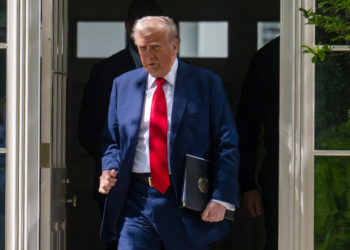Jamie Dettmer is opinion editor at POLITICO Europe.
Donald Trump will complete his first 100 days in office this week. But despite the U.S. president’s campaign boast about how easily he could settle the Ukraine war in just one day, he still hasn’t managed to broker a ceasefire — let alone a deal to permanently end the conflict.
His administration seems hopeful that will change this week. But if the U.S. does manage to engineer a ceasefire, there should be grave doubts it will be the final word on Russian President Vladimir Putin’s revanchism.
“We’re close, but we’re not close enough,” said U.S. Secretary of State Marco Rubio this weekend, emphasizing the Trump administration is ready to “walk away” if there’s no breakthrough — a threat his boss has also made.
Yet, Washington’s tone remains upbeat in the wake of Trump’s 15-minute discussion with Ukrainian President Volodymyr Zelenskyy on the sidelines of Pope Francis’ funeral. It was the first time they’d met since their nasty Oval Office spat in February.
Both leaders said the encounter was productive, and Zelenskyy hailed it as potentially “historic.” Meanwhile, Washington also described last week’s meeting between Putin and Trump’s Special Envoy to the Middle East Steve Witkoff as productive.
But the U.S. president’s frustration has been building.
Since taking office, he’s been bullying Zelenskyy, blaming him for the war, while playing much nicer with the much less vulnerable Russian leader who actually started the conflict. Witkoff, for his part, has been happily repeating Kremlin talking points, and waxed lyrical about Putin praying for Trump upon learning of the assassination attempt on his life last July.
Last week, however, Trump offered a rare public rebuke of Putin, after the deadliest Russian attack on Ukraine’s capital since last summer. “Vladimir, STOP!” the U.S. president posted on Truth Social, saying he was “not happy” with the assault. He then threatened Russia with sanctions after his meeting with Zelenskyy in St Peter’s Basilica.
So, is this rare reproach and economic threat responsible for some sort of shift in Moscow? Is that the reason Trump and his aides believe they’re nearer a deal? Or is Zelenskyy the one caving?
No matter what, a healthy dose of skepticism remains in order. Russia’s Minister of Foreign Affairs Sergey Lavrov appeared to harden Moscow’s position on annexed territories in eastern Ukraine in an interview this weekend. And we’ve heard optimistic noises from the Trump administration about the proximity of a deal before. Further caution is also advisable, as the deal’s broad contours have not actually shifted much: It still includes Ukraine never joining NATO, effectively ceding much of the territory Russia has occupied, U.S. recognition of the Crimean peninsula, and lifting sanctions on Russia.
The U.S. position is that in return, Ukraine will be given a “robust security guarantee” by European countries and other friendly states acting as guarantors, but the details on that are murky. And in addition to deeper energy and economic cooperation between the U.S. and Russia, Kyiv will have to sign a minerals deal giving the U.S. half of the revenue from its natural resources, while the Zaporizhzhia Nuclear Power Plant — controlled by Kyiv but operated by the U.S. — will have to supply both Ukraine and Russia with electricity.
There is no doubt this is a terrible deal for Ukraine. The bloodletting may halt, but not only will Kyiv emerge from this brutal war dismembered, it will also have no credible security guarantee, as Washington is declining to backstop the Europeans. There will be no accountability for documented Russian war crimes, nor will there be any clear compensation from Moscow, as far as we know, for the damage it inflicted. (While the latter is included in the text, there’s no explanation of where the money will come from — or how much.)
This is hardly the “peace through strength” strategy that Trump’s increasingly sidelined Special Envoy for Ukraine Keith Kellogg had outlined: “We tell the Ukrainians, ‘You’ve got to come to the table, and if you don’t come to the table, support from the United States will dry up.’ And you tell Putin, ‘He’s got to come to the table and if you don’t come to the table, then we’ll give Ukrainians everything they need to kill you in the field,’” Kellogg had said.
But only half of that equation was put into effect. Ukraine is the only party making concessions. Furthermore, this will mark the first time in postwar history that European borders will be redrawn by force of arms — a bad precedent in itself.
Trump aides do have a point, however, when they argue it’s been clear Ukraine would have to cede some territory. This column has argued the war was unwinnable for Ukraine for the past two years, and has been critical of the West’s promises to stick with Ukraine until its 1991 borders are restored.
There was, of course, a moment when this might not have been the case — if the West hadn’t dithered at the start of the war. “Russian troops could have been defeated and expelled from Ukraine back in 2022, if the West had initially taken a tough stance toward Russia, and Ukraine had received the necessary amount of weapons,” explained former Russian diplomat Boris Bondarev.
But once the West chose to be afraid, the “as long as it takes” mantra was always suspect, as was the frequent assertion that no one should push Ukraine into talks because whoever pays the piper calls the tune. The promise of NATO membership was also a folly, as it was clear Moscow would never allow that to happen.
Far too much hope was placed in economic sanctions, which were never likely to bring Russia to heel. Plus, attritional war always favored Russia, especially as there was no chance Western allies would enter the war as combatants.
In short, an ugly deal was predictable. If you run down your military forces and arms production for decades, fail to draw enforceable red lines and don’t ask hard questions before making promises, this is what happens.
This means Putin’s thuggishness will be rewarded, and there will be no accountability for his army’s atrocious behavior or the unlawful, detestable deportations to Russia from occupied parts of Ukraine. Additionally, the axis of autocrats will be emboldened in their determination to smash the old global order.
More devastatingly, it also means Ukraine will be the punished party — not Russia. And without a U.S.-backed security guarantee, the ceasefire deal will be as worthless as the notorious 1994 Budapest Memorandum, which fixed Ukraine’s borders and underwrote its sovereignty in exchange for the country relinquishing its Soviet-era nuclear arsenal. Putin didn’t observe Russia’s 1994 commitments, and it is unlikely he’ll abide by the proposed deal now.
As Ukraine’s former Minister of Defense Oleksii Reznikov noted to POLITICO last year: “They may sign documents, but whether they keep to agreements is another matter. Remember the Budapest Memorandum. French President Mitterrand refused to add his signature … and warned our president [Leonid Kuchma], ‘Young man, they will trick you.’ Kuchma told me this story. After 30 years, the Russians did just that — they tricked us.”
And without security guarantees and a firm “porcupine strategy” to make sure Ukraine will be heavily armed and even more dangerous to mess with, there’s a trick here too. The deal will likely spell the end of Zelenskyy’s presidency and throw Ukraine into political turmoil over the deal, as ceding territory will likely require a constitutional amendment and referendum.
Putin will then have plenty of opportunity to exploit these political divisions, making the deal just a way station in his revanchist bid to subjugate the country.
The post An ugly Ukraine deal was predictable — but this will merely pause Russia’s revanchism appeared first on Politico.




